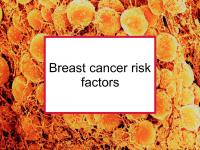A new study has ranked well-established breast cancer risk factors for postmenopausal breast cancer. The authors divided the factors into those over which women have little or no control, such as height, and those that are modifiable, such as obesity, exercise (level of physical activity) and alcohol consumption.
The authors estimate that, generally speaking, women who avoid the most important modifiable risk factors could potentially reduce their risk of postmenopausal breast cancer by almost 40%.
Study design
To conduct the study, the authors used data from the Nurses' Health Study (NHS), an ongoing prospective study of 121,700 U.S. nurses that began in 1976. A total of 8,421 postmenopausal study participants developed invasive breast cancer during the investigation period (1980 to 2008). The authors analyzed data concerning two types of risk factors—those that are unmodifiable or difficult to modify (especially in middle age) and those that can be changed.
Unmodifable risk factors
- Current age — breast cancer risk increases with age
- Age at first period (menarche) — early menarche increases risk
- Height — tall height is associated with increased risk
- Age at first birth/children — having no children or having them late increases risk
- Family history of breast cancer — a family history increases risk
- Benign breast disease — a history of some types of benign breast disease increases risk
Modifable risk factors
- Breast feeding — generally speaking, breast feeding reduces risk
- Current adult BMI — obesity increases risk
- Weight change since age 18 — significant adult weight gain increases risk
- Alcohol consumption — alcohol consumption increases risk
- Level of physical activity — regular exercise or physical activity reduces risk
- Use of HRT (hormone replacement therapy) — combined HRT increases risk
The authors calculated population attributable risk percents (PARs) for each breast cancer risk factor. The population attributable risk percent is the proportion of cases that would not occur in a population if the risk factor were eliminated. Analyses were performed for invasive breast cancer overall, as well as estrogen receptor positive (ER+) and ER- breast cancer.
Some of the risk factors that are unmodifiable once a woman has reached middle age can be addressed at a younger age. This applies to some of our high-risk daughters. Please see our article on how we can protect our daughters from breast cancer for more information.
Study Results
Early age of first period, being tall, increasing weight gain since age 18, increasing alcohol consumption, and current use of HRT (also known as menopausal hormone therapy) each were found to be associated with increased risk of breast cancer, as expected. Since age is strongly associated with breast cancer risk, the authors estimated the PARs both with and without age. When age was excluded in the model, the PAR for invasive breast cancer was 0.62. In other words, if women could somehow change to the lowest risk category for all of the variables apart from age, invasive breast cancers would be reduced by 62%. When age was included, the PAR was 0.92 overall for invasive breast cancer, 0.95 for ER+ breast cancer and 0.86 for ER- breast cancer.
However, since many of the risk factors cannot realistically be changed, the authors also analyzed more readily modifiable risk factors singly and in combinations. The risk factor with the largest PAR, was found to be BMI/weight gain since age 18 (PAR=0.24). Risk factors related to reproduction, including age at first birth/parity (PAR=0.10) and age at first period (PAR=0.08) were also found to have modest impacts on PAR—both were higher for ER+ than ER- disease. When the authors analyzed all of the modifiable risk factors together, it was found that having the lowest weight gain, drinking no alcohol, engaging in high regular physical activity, breast feeding, and never using HRT was associated with a PAR of 0.38 for invasive breast cancer. The authors conclude that known breast cancer risk factors explain a large fraction of both ER+ and ER- postmenopausal breast cancers. The most important modifiable risk factor is maintaining a healthy weight, according to the authors.
